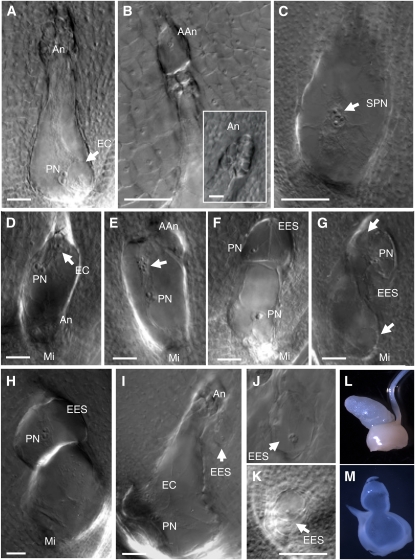Figure 4.
Downregulation of dmt102 and dmt103 in Sexual Maize Induces the Formation of Multiple ESs in the Ovule.
(A) Wild-type MES. An, antipodal cells; EC, egg cell; PN, polar nuclei.
(B) MES in a dmt102::Mu line with abnormal development of antipodal cells (AAn). The caption shows wild-type antipodal development in B73.
(C) to (K) Abnormal gametophyte development in the dmt103 RNAi lines. (C) and (D) DMT103-4. (E) to (K) DMT103-2.
(C) MES with supernumerary, but normally positioned, polar nuclei (SPN).
(D) MES in inverted position showing antipodal cells at the micropylar side (Mi).
(E) MES with proliferating nuclei (arrow). Note also the absence of normal antipodal cells and the development of enlarged cells (AAn), as shown in (B).
(F) to (H) MESs showing development of two (F) or one ([G] and [H]) extra ES (EES) at the chalazal end containing clearly differentiated polar nuclei and egg cells (arrows).
(I) and (J) Development of an enlarged cell (arrow and magnified in [J]) in the nucellus.
(K) Development of multiple uninucleate gametophytes (arrows) in young ovules.
(L) to (M) Overproliferation of nucellar cells in dmt103-6 (observed in 46% of the ovaries) that extrude from the ovule; intact mature ovary prior to fertilization (L) and section at the same stage (M) showing continuity of nucellar tissues.
Bars = 25 μm.
[See online article for color version of this figure.]

